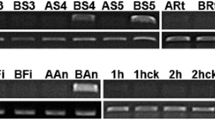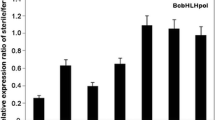Abstract
Key message
BcMF11 as a non-coding RNA gene has an essential role in pollen development, and might be useful for regulating the pollen fertility of crops by antisense RNA technology.
Abstract
We previously identified a 828-bp full-length cDNA of BcMF11, a novel pollen-specific non-coding mRNA-like gene from Chinese cabbage (Brassica campestris L. ssp. chinensis Makino). However, little information is known about the function of BcMF11 in pollen development. To investigate its exact biological roles in pollen development, the BcMF11 cDNA was antisense inhibited in transgenic Chinese cabbage under the control of a tapetum-specific promoter BcA9 and a constitutive promoter CaMV 35S. Antisense RNA transgenic plants displayed decreasing expression of BcMF11 and showed distinct morphological defects. Pollen germination test in vitro and in vivo of the transgenic plants suggested that inhibition of BcMF11 decreased pollen germination efficiency and delayed the pollen tubes’ extension in the style. Under scanning electron microscopy, many shrunken and collapsed pollen grains were detected in the antisense BcMF11 transgenic Chinese cabbage. Further cytological observation revealed abnormal pollen development process in transgenic plants, including delayed degradation of tapetum, asynchronous separation of microspore, and aborted development of pollen grain. These results suggest that BcMF11, as a non-coding RNA, plays an essential role in pollen development and male fertility.






Similar content being viewed by others
Abbreviations
- BcMF11 :
-
Brassica campestris Male Fertility 11
- CaMV:
-
Cauliflower mosaic virus
- ncRNA:
-
Non-coding RNA
- ORF:
-
Open reading frame
- RT-PCR:
-
Reverse transcription-polymerase chain reaction
References
Ariizumi T, Hatakeyama K, Hinata K, Inatsugi R, Nishida I, Sato S, Kato T, Tabata S, Toriyama K (2004) Disruption of the novel plant protein NEF1 affects lipid accumulation in the plastids of the tapetum and exine formation of pollen, resulting in male sterility in Arabidopsis thaliana. Plant J 39(2):170–181
Aspegren A, Larsson P, Larsson A, Soderbom F (2004) Novel non-coding RNAs in Dictyostelium discoideum and their expression during development. Nucleic Acids Res 32(15):4646–4656
Beltran JP, Roque E, Medina M, Madueno F, Gomez MD, Canas LA (2007) Male-sterility obtained by genetic engineering: principles and biotechnological applications. Anal Real Acad Nal Farm 73(4):1237–1264
Billoud B, De Paepe R, Baulcombe D, Boccara M (2005) Identification of new small non-coding RNAs from tobacco and Arabidopsis. Biochimie 87:905–910
Campalans A, Kondorosi A, Crespi M (2004) Enod40, a short open reading frame-containing mRNA, induces cytoplasmic localization of a nuclear RNA binding protein in Medicago truncatula. Plant Cell 16:1047–1059
Cao JS, Cao SC, Yi QM (1995) RAPD analysis on genomic DNA of Chinese cabbage and the other groups of Brassica. Acta Hortic Sinica 22:47–52
Cao JS, Yu XL, Ye WZ, Lu G, Xiang X (2006) Functional analysis of a novel male fertility CYP86MF gene in Chinese cabbage (Brassica campestris L. ssp. chinensis makino). Plant Cell Rep 24(12):715–723
Chen XM (2009) Small RNAs and their roles in plant development. Annu Rev Cell Dev Biol 25:21–44
Dai XY, Yu JJ, Ma JX, Ao GM, Zhao Q (2007) Overexpression of zm401, an mRNA-like RNA, has distinct effects on pollen development in maize. Plant Growth Regul 52:229–239
de Mesa MC, Santiago-Domenech N, Pliego-Alfaro F, Quesada MA, Mercado JA (2004) The CaMV 35S promoter is highly active on floral organs and pollen of transgenic strawberry plants. Plant Cell Rep 23(1–2):32–38
Dobritsa AA, Shrestha J, Morant M, Pinot F, Matsuno M, Swanson R, Moller BL, Preuss D (2009) CYP704B1 is a long-chain fatty acid omega-hydroxylase essential for sporopollenin synthesis in pollen of Arabidopsis. Plant Physiol 151(2):574–589
Donald GJ, Deborah CH, Elizabeth AT, David JK, Katharine RT (2000) Inhibition of Plasmodium falciparum clag9 gene function by antisense RNA. Mol Biochem Parasitol 110:33–41
Franco-Zorrilla JM, Valli A, Todesco M, Mateos I, Puga MI, Rubio-Somoza I, Leyva A, Weigel D, García JA, Paz-Ares J (2007) Target mimicry provides a new mechanism for regulation of microRNA activity. Nat Genet 39:1033–1037
Fujimoto R, Sugimura T, Nishio T (2006) Gene conversion from SLG to SRK resulting in self-compatibility in Brassica rapa. FEBS Lett 580(2):425–430
Goldberg RB, Beals TP, Sanders PM (1993) Anther development: basic principles and practical applications. Plant cell 5(10):1217–1229
Grant-Downton R, Le Trionnaire G, Schmid R, Rodriguez-Enriquez J, Hafidh S, Mehdi S, Twell D, Dickinson H (2009) MicroRNA and tasiRNA diversity in mature pollen of Arabidopsis thaliana. BMC Genomics 10:643
Gupta R, Ting JTL, Sokolov LN, Johnson SA, Luan S (2002) A tumor suppressor homolog, AtPTEN1, is essential for pollen development in Arabidopsis. Plant Cell 14:2495–2507
Hobert O (2008) Gene regulation by transcription factors and microRNAs. Science 319:1785–1786
Hüttenhofer A, Schattner P, Polacek N (2005) Non-coding RNAs: hope or hype? Trends Genet 21(5):289–297
Ito T, Shinozaki K (2002) The MALE STERILITY1 gene of Arabidopsis, encoding a nuclear protein with a PHD finger motif, is expressed in the tapetal cells and is required for pollen maturation. Plant Cell Physiol 43:1285–1292
Jin Y, Tashpulatov AS, Katholnigg H, Heberle-Bors E, Touraev A (2006) Isolation and characterisation of two wheat beta-expansin genes expressed during male gametophyte development. Protoplasma 228(1–3):13–19
Jung KH, Han MJ, Lee YS, Kim YW, Hwang I, Kim MJ, Kim YK, Nahm BH, An G (2005) Rice undeveloped Tapetum1 is a major regulator of early tapetum development. Plant Cell 17:2705–2722
Kawanabe T, Ariizumi T, Kawai-Yamada M, Uchimiya H, Toriyama K (2006) Abolition of the tapetum suicide program ruins microsporogenesis. Plant Cell Physiol 47(6):784–787
Kempe K, Gils M (2011) Pollination control technologies for hybrid breeding. Mol Breeding 27(4):417–437
Khraiwesh B, Arif MA, Seumel GI, Ossowski S, Weigel D, Reski R, Frank WG (2010) Transcriptional control of gene expression by microRNAs. Cell 140(1):111–122
Knoester M, Linthorst HJM, Bol JF, van Loon LC (1997) Modulation of stress-inducible ethylene biosynthesis by sense and antisense gene expression in tobacco. Plant Sci 126:173–183
Kouchi H, Takane K, So RB, Ladha JK, Reddy PM (1999) Rice ENOD40: isolation and expression analysis in rice and transgenic soybean root nodules. Plant J 18:121–129
Lee YH, Chung KH, Kim HU, Jin YM, Kim HI, Park BS (2003) Introduction of male sterile cabbage using a tapetum-specific promoter from Brassica campestris L. ssp. pekinensis. Plant Cell Rep 22:268–273
Lelandais-Briere C, Naya L, Sallet E, Calenge F, Frugier F, Hartmann C, Gouzy J, Crespi M (2009) Genome-wide medicago truncatula small RNA analysis revealed novel microRNAs and isoforms differentially regulated in roots and nodules. Plant Cell 21(9):2780–2796
Li J, Yu MA, Geng LL, Zhao J (2010) The fasciclin-like arabinogalactan protein gene, FLA3, is involved in microspore development of Arabidopsis. Plant J 64(3):482–497
Ma JX, Zhao Q, Yu JJ, Ao GM (2005) Ectopic expression of a maize pollen specific gene, zm401, results in aberrant anther development in tobacco. Euphytica 144(1–2):133–140
Ma JX, Yan BX, Qu YY, Qin FF, Yang YT, Hao XJ, Yu JJ, Zhao Q, Zhu DY, Ao GM (2008) Zm401, a short-open reading-frame mRNA or noncoding RNA, is essential for tapetum and microspore development and can regulate the floret formation in maize. J Cell Biochem 105:136–146
Mallory AC, Vaucheret H (2006) Functions of microRNAs and related small RNAs in plants. Nat Genet 38:S31–S36
McCormick S (2004) Control of male gametophyte development. Plant Cell 16:S142–S153
McNeil KJ, Smith AG (2010) A glycine-rich protein that facilitates exine formation during tomato pollen development. Planta 231(4):793–808
Nonomura KI, Miyoshi K, Eiguchi M, Suzuki T, Miyao A, Hirochika H, Kurata N (2003) The MSP1 gene is necessary to restrict the number of cells entering into male and female sporogenesis and to initiate anther wall formation in rice. Plant Cell 15:1728–1739
Parish RW, Li SF (2010) Death of a tapetum: a programme of developmental altruism. Plant Sci 178(2):73–89
Park HC, Kang YH, Chun HJ, Koo JC, Cheong YH, Kim CY, Kim MC, Chung WS, Kim JC, Yoo JH, Koo YD, Koo SC, Lim CO, Lee SY, Cho MJ (2002) Characterization of a stamen-specific cDNA encoding a novel plant defensin in Chinese cabbage. Plant Mol Biol 50(1):59–69
Park BS, Kim JS, Kim SH, Park YD (2005) Characterization of a pollen-preferential gene, BAN102, from Chinese cabbage. Plant Cell Rep 24(11):663–670
Paul W, Hodge R, Smarrt S, Draper J, Scott R (1992) The isolation and characterization of the tapetum-specific Arabidopsis thaliana A9 gene. Plant Mol Biol 19:611–622
Roque E, Gomez MD, Ellul P, Wallbraun M, Madueno F, Beltran JP, Canas LA (2007) The PsEND1 promoter: a novel tool to produce genetically engineered male-sterile plants by early anther ablation. Plant Cell Rep 26(3):313–325
Sambrook J, Russell DW (2001) Molecular cloning: a laboratory manual, 3rd edn. Cold Spring Harbor Laboratory Press, New York
Scott R, Hodge R, Paul W, Draper J (1991) The molecular biology of anther differentiation. Plant Sci 80:167–191
Song JH, Cao JS, Yu XL, Xiang X (2007) BcMF11, a putative pollen-specific non-coding RNA from Brassica campestris L. ssp. chinensis Makino. J Plant Physiol 164(8):1097–1100
Song JH, Zhang LX, Cao JS (2009) Molecular cloning and characterization of a novel pollen predominantly membrane protein from Chinese cabbage. Mol Biol Rep 36(8):2307–2314
Steiner C, Bauer J, Amrhein N, Bucher M (2003) Two novel genes are differentially expressed during early germination of the male gametophyte of Nicotiana tabacum. Biochim Biophys Acta 1625(2):123–133
Steiner-Lange S, Unte US, Eckstein L, Yang CY, Wilson ZA, Schmelzer E, Dekker K, Saedler H (2003) Disruption of Arabidopsis thaliana MYB26 results in male sterility due to non-dehiscent anthers. Plant J 34(4):519–528
Storz G (2002) An expanding universe of noncoding RNAs. Science 296:1260–1262
Sumie I, Akiko K, Junichi U, Ikuo N, Kiyotaka O (2001) The DEFECTIVE IN ANTHER DEHISCENCE1 gene encodes a novel phospholipase A1 catalyzing the initial step of jasmonic acid biosynthesis, which synchronizes pollen maturation, anther dehiscence, and flower opening in Arabidopsis. Plant Cell 10:2191–2210
Teramoto H, Toyama T, Takeba G, Tsuji H (1996) Noncoding RNA for CR20, a cytokinin-repressed gene of cucumber. Plant Mol Biol 32:797–808
Wei LQ, Yan LF, Wang T (2011) Deep sequencing on genome-wide scale reveals the unique composition and expression patterns of microRNAs in developing pollen of Oryza sativa. Genome Biol 12:R53
Wilkinson JE, Twell D, Lindsey K (1997) Activities of CaMV 35S and nos promoters in pollen: implications for field release of transgenic plants. J Exp Bot 48(307):265–275
Wilson ZA, Morroll SM, Dawson J, Swarup R, Tighe PJ (2001) The Arabidopsis MALE STERILITY1 (MS1) gene is a transcriptional regulator of male gametogenesis, with homology to the PHD finger family of transcription factors. Plant J 28:27–39
Wilson ZA, Song J, Taylor B, Yang CY (2011) The final split: the regulation of anther dehiscence. J Exp Bot 62(5):1633–1649
Yi J, Kim SR, Lee DY, Moon S, Lee YS, Jung KH, Hwang I, An G (2012) The rice gene DEFECTIVE TAPETUM AND MEIOCYTES 1 (DTM1) is required for early tapetum development and meiosis. Plant J 70(2):256–270
Yu XL, Cao JS, Ye WZ, Wang YQ (2004) Construction of an antisense CYP86MF gene plasmid vector and production of a male-sterile Chinese cabbage transformant by the pollen-tube method. J Hortic Sci Biotechnol 79:833–839
Zhou ZF, Dun XL, Xia SQ, Shi DY, Qin MM, Yi B, Wen J, Shen JX, Ma CZ, Tu JX, Fu TD (2012) BnMs3 is required for tapetal differentiation and degradation, microspore separation, and pollen-wall biosynthesis in Brassica napus. J Exp Bot 63(5):2041–2058
Acknowledgments
This work was supported by the National Natural Science Foundation of China (No. 30800750, 31071805, 31272170) and the Natural Science Foundation of Anhui Province (No. 10040606Q20).
Author information
Authors and Affiliations
Corresponding author
Additional information
Communicated by H. Judelson.
Electronic supplementary material
Below is the link to the electronic supplementary material.
Rights and permissions
About this article
Cite this article
Song, JH., Cao, JS. & Wang, CG. BcMF11, a novel non-coding RNA gene from Brassica campestris, is required for pollen development and male fertility. Plant Cell Rep 32, 21–30 (2013). https://doi.org/10.1007/s00299-012-1337-6
Received:
Revised:
Accepted:
Published:
Issue Date:
DOI: https://doi.org/10.1007/s00299-012-1337-6




